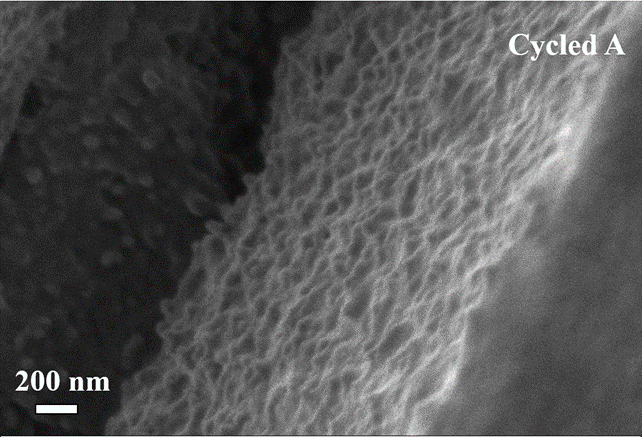Scientists at the University of Eastern Finland have created a self-standing mesoporous silicon (Si) film anode for lithium-ion batteries.
 SEM image of the cross-section of the optimal Si film electrode after cycling. Image Credit: Vesa-Pekka Lehto.
SEM image of the cross-section of the optimal Si film electrode after cycling. Image Credit: Vesa-Pekka Lehto.
This innovative film electrode does not need carbon supplements and binders to link particles akin to standard slurry-based electrodes, but it still displays superior battery performance. The achievement of this electrode design offers an efficient approach for accomplishing high-energy density in lithium-ion batteries.
The creation of high-performance lithium-ion batteries has been very desirable because of their extensive applications in portable electronics and in hybrid and electric vehicles. Silicon is the most favorable anode material for advanced lithium-ion batteries because of its high theoretical precise capacity and nontoxic electrochemical potential.
However, Si anode suffers from large volume expansion and contraction while cycling, which results in electrical contact loss between silicon and other battery parts, ultimately resulting in the failure of the battery.
Battery scientists around the world have been committing their efforts toward enhancing the performance of Si electrodes, including scientists at the University of Eastern Finland. Applying the electrochemical etching technique, they created a self-standing mesoporous Si film anode for lithium-ion batteries.
The concept is that the pores of mesoporous silicon can house the volume expansion during cycling, thus resulting in stable battery cycling. They methodically analyzed the influences of pore features on the performance of the electrode using correlation analysis and discovered their relationship.
Comprehensive pore analysis and electrochemical representation of the Si films were carried out to examine their correlation. Correlation analysis revealed that both initial Coulombic efficiency (ICE) and reversible specific capacity possess a robust negative correlation with the surface area and porosity, while the performance of cycling is controlled by the film thickness over the pore features.
A single positive correlation was discovered between the long-standing cycling stability and the diameter of the pore. The most suitable Si film anode provides an ICE of 81.2% and stable cycling for more than 450 cycles with a minimal specific capacity of 1200 mAh g−1 in half cells.
The research shows the direction of the porous silicon material for high-performance lithium-ion batteries. More significantly, it offers the scientists in battery material research, particularly Si anode, a better insight into the dynamics involved in assessing the electrode performance and creating more economical evaluation approaches for battery research.
Journal Reference:
Zhao, X., et al. (2022) Self-Standing Mesoporous Si Films as Anodes for Lithium-Ion Microbatteries. Journal of Power Sources. doi.org/10.1016/j.jpowsour.2022.231269.